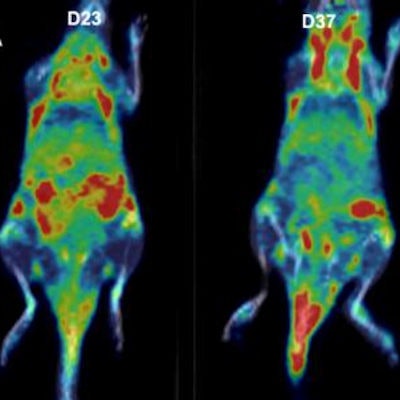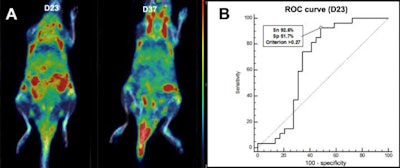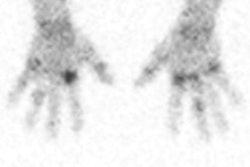
Researchers from South Korea have developed a novel PET tracer that can be used to visualize joint inflammation in mice and potentially could provide an early diagnosis of rheumatoid arthritis in humans, according to a preclinical study in the Journal of Nuclear Medicine.
The researchers used the radiolabeled ligand F-18 FEDAC to target the translocator protein (TSPO), which is abundant in white blood cells known as macrophages. F-18 FEDAC targets TSPO and binds to it (JNM, May 2018, Vol. 59:5, pp. 839-845).
"This study ... showed the value of F-18 FEDAC PET as an inflammation biomarker for early detection of rheumatoid arthritis, even before onset of clinical symptoms of joints," said lead author Dr. Gi Jeong Cheon, PhD, of Seoul National University College of Medicine, in a release from the Society of Nuclear Medicine and Molecular Imaging (SNMMI).
For the study, the researchers tested F-18 FEDAC in a mouse model, using both the novel tracer and FDG-PET. They found increased TSPO messenger RNA and protein expression in activated macrophages, and there was greater uptake of F-18 FEDAC in activated macrophages than nonactivated cells. The uptake of F-18 FEDAC increased earlier in arthritic joints (day 23); however, the uptake of FDG increased later (day 37), reaching a higher level.
 On day 23 and day 37, increased uptake (A) is noted in the front and hind paws of this mouse with collagen-induced arthritis. Graph shows predictive performance (B) of F-18 FEDAC uptake on day 23 for the development of clinical arthritis. ROC = receiver operating characteristic; Sn = sensitivity; Sp = specificity. Images courtesy of Seoul National University and Ewha Womans University.
On day 23 and day 37, increased uptake (A) is noted in the front and hind paws of this mouse with collagen-induced arthritis. Graph shows predictive performance (B) of F-18 FEDAC uptake on day 23 for the development of clinical arthritis. ROC = receiver operating characteristic; Sn = sensitivity; Sp = specificity. Images courtesy of Seoul National University and Ewha Womans University.The preliminary results suggest that F-18 FEDAC could help visualize active inflammation in arthritic joints by targeting TSPO expression in activated macrophages, and it may be useful when rheumatoid arthritis is suspected.
"From our data, we found that each tracer may be useful for different information about arthritis -- F-18 FEDAC for early detection of subclinical arthritis and F-18 FDG for measuring disease activity of symptomatic arthritis," Cheon said.



















